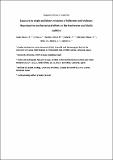Por favor, use este identificador para citar o enlazar a este item:
http://hdl.handle.net/10261/201448COMPARTIR / EXPORTAR:
 SHARE SHARE
 CORE
BASE CORE
BASE
|
|
| Visualizar otros formatos: MARC | Dublin Core | RDF | ORE | MODS | METS | DIDL | DATACITE | |

| Campo DC | Valor | Lengua/Idioma |
|---|---|---|
| dc.contributor.author | López-Doval, Julio César | es_ES |
| dc.contributor.author | Freixa, Anna | es_ES |
| dc.contributor.author | Santos, Lúcia H.M.L.M. | es_ES |
| dc.contributor.author | Sanchís, Josep | es_ES |
| dc.contributor.author | Rodríguez-Mozaz, Sara | es_ES |
| dc.contributor.author | Farré, Marinella | es_ES |
| dc.contributor.author | Barceló, Damià | es_ES |
| dc.contributor.author | Sabater, Sergi | es_ES |
| dc.date.accessioned | 2020-02-21T07:21:26Z | - |
| dc.date.available | 2020-02-21T07:21:26Z | - |
| dc.date.issued | 2019-09 | - |
| dc.identifier.citation | Environmental Research 176: 108565 (2019) | es_ES |
| dc.identifier.uri | http://hdl.handle.net/10261/201448 | - |
| dc.description.abstract | Emerging pollutants occur in complex mixtures in rivers and have the potential to interact with freshwater organisms. The chronic effects of nominal exposure to 3 μg/L of fullerenes (C60) and 1 μg/L of triclosan (TCS) alone and in a binary mixture, were evaluated using the freshwater snail Radix balthica. Pollutants accumulation, reproductive output and feeding behavior were selected as sublethal endpoints. After 21 days of exposure, we did not observe interactive effects between TCS and C60 on the studied endpoints, except for the accumulation of C60 in R. balthica in TCS + C60 treatment, which was lower than when the fullerenes were alone. Neither TCS nor C60 caused significant effects on reproduction, expressed as number of eggs per individual, but an increase in the clutch size was observed in treatments with TCS at the third week of exposure, independently of the presence of C60 (16.15 ± 1.67 and 18.9 ± 4.01 eggs/egg mass in TCS and TCS + C60 treatments, respectively, vs. 13.17 ± 4.01 in control). The presence of C60 significantly enhanced the grazing activity of R. balthica during the first seven days (4.95 ± 1.35 and 3.91 ± 0.59% of the area grazed per individual in C60 and TCS + C60 treatments, respectively, vs 2.6 ± 0.39% in control). The accumulation of TCS was quite similar in treatments where this pollutant was present (BAF ≈ 1007 L/kg d.w.); however, the accumulation of C60 was higher when the nanoparticles were alone (BAF = 254.88 L/kg d.w.) than when it was in the binary mixture (BAF = 7.79 L/kg d.w). Overall, although TCS has been listed as an endocrine disrupter compound, no significant effects on reproduction were observed in the assayed conditions. Regarding C60, the limited effects on feeding activity and the low BAF obtained in this experiment indicate that fullerenes do not have ecological consequences of relevance at the studied environmental concentrations in freshwater snails. © 2019 Elsevier Inc. | es_ES |
| dc.description.sponsorship | This work was supported by the Spanish Ministry of Economy and Competitiveness through the project NANO-transfer (ERA-NET SIINN PCIN-2015-182-CO2-01) and by the Generalitat de Catalunya (Consolidated Research Groups “2014 SGR 418 – Water and Soil Quality Unit” and “2014 SGR 291 – ICRA”). Julio C. López-Doval (IJCI-2015-23644), Lúcia H.M.L.M. Santos (FJCI-2014-22377 and IJCI-2017-32747) and Anna Freixa (FJCI-2017-33171) acknowledge the Juan de la Cierva program from the Spanish Ministry of Economy and Competitiveness. Sara Rodriguez-Mozaz acknowledges the Ramon y Cajal program (RYC-2014-16707). | es_ES |
| dc.language.iso | eng | es_ES |
| dc.publisher | Elsevier | es_ES |
| dc.relation | info:eu-repo/grantAgreement/MINECO/Plan Estatal de Investigación Científica y Técnica y de Innovación 2013-2016/PCIN-2015-182-C2-1 | es_ES |
| dc.relation.isversionof | Postprint | es_ES |
| dc.rights | openAccess | en_EN |
| dc.subject | Accumulation | es_ES |
| dc.subject | Chemical mixtures | es_ES |
| dc.subject | C60 fullerenes | es_ES |
| dc.subject | Freshwater invertebrates | es_ES |
| dc.subject | Simple food web | es_ES |
| dc.title | Exposure to single and binary mixtures of fullerenes and triclosan: Reproductive and behavioral effects in the freshwater snail Radix balthica | es_ES |
| dc.type | artículo | es_ES |
| dc.identifier.doi | 10.1016/j.envres.2019.108565 | - |
| dc.description.peerreviewed | Peer reviewed | es_ES |
| dc.relation.publisherversion | https://doi.org/10.1016/j.envres.2019.108565 | es_ES |
| dc.embargo.terms | 2021-09-01 | es_ES |
| dc.contributor.funder | Ministerio de Economía y Competitividad (España) | es_ES |
| dc.relation.csic | Sí | es_ES |
| oprm.item.hasRevision | no ko 0 false | * |
| dc.identifier.funder | http://dx.doi.org/10.13039/501100003329 | es_ES |
| dc.contributor.orcid | Sanchís, Josep [0000-0002-6812-9981] | es_ES |
| dc.contributor.orcid | Farrè, Marinella [0000-0001-8391-6257] | es_ES |
| dc.contributor.orcid | Barceló, Damià [0000-0002-8873-0491] | es_ES |
| dc.type.coar | http://purl.org/coar/resource_type/c_6501 | es_ES |
| item.fulltext | With Fulltext | - |
| item.languageiso639-1 | en | - |
| item.openairecristype | http://purl.org/coar/resource_type/c_18cf | - |
| item.openairetype | artículo | - |
| item.cerifentitytype | Publications | - |
| item.grantfulltext | open | - |
| Aparece en las colecciones: | (IDAEA) Artículos | |
Ficheros en este ítem:
| Fichero | Descripción | Tamaño | Formato | |
|---|---|---|---|---|
| Exposure to single and binary mixtures of fullerenes and triclosan.pdf | Artículo principal | 768,49 kB | Adobe PDF |  Visualizar/Abrir |
| 1-s2.0-S0013935119303627-mmc1.pdf | Material suplementario | 133,09 kB | Adobe PDF |  Visualizar/Abrir |
CORE Recommender
SCOPUSTM
Citations
8
checked on 22-abr-2024
WEB OF SCIENCETM
Citations
6
checked on 29-feb-2024
Page view(s)
179
checked on 24-abr-2024
Download(s)
374
checked on 24-abr-2024
Google ScholarTM
Check
Altmetric
Altmetric
NOTA: Los ítems de Digital.CSIC están protegidos por copyright, con todos los derechos reservados, a menos que se indique lo contrario.
